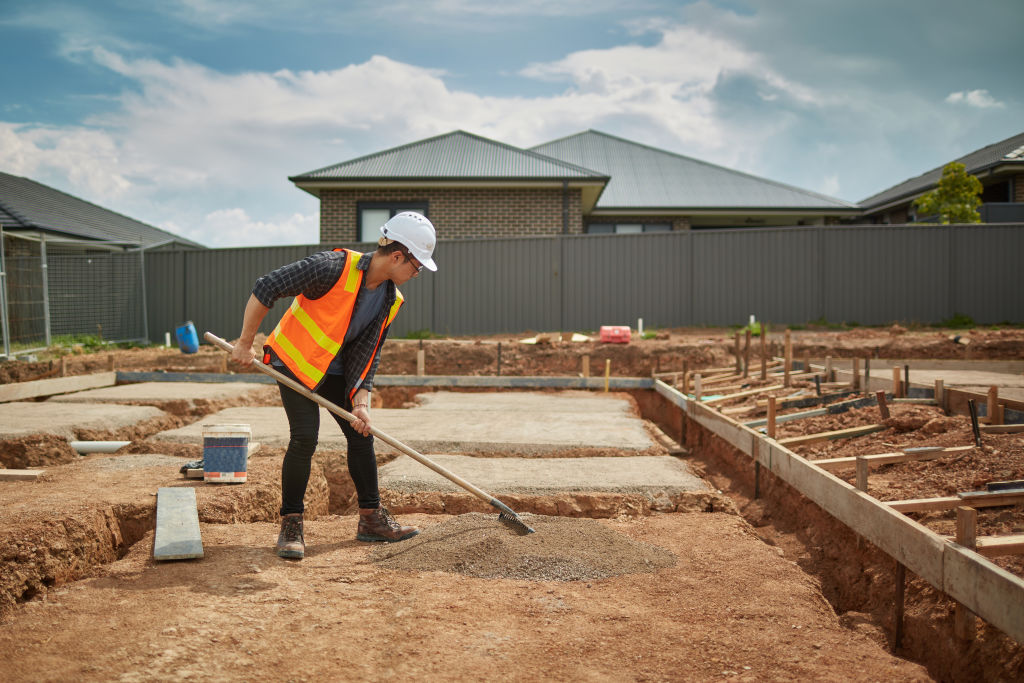Sharp decline in commencements suggest the downturn has hit the construction sector

A housing market downswing is a double-edged sword. Aspiring home owners are breathing a sigh of relief at falling property prices in Sydney and Melbourne but construction workers might see things differently.
Construction, including home building, infrastructure and commercial construction, is Australia’s second-largest contributor to annual economic output (behind financial services), figures from the Australian Bureau of Statistics show.
The construction sector may be far from the highs of the mining boom, which brought unprecedented levels of investment through civil engineering construction, but the east-coast housing boom had at least kept the sector buoyant.
Building construction alone saw $30.6 billion gross value added to the economy in the year to September 2018 (1.7 per cent of nominal GDP).
Between 2014 and 2018, about 19,000 dwellings were approved for construction each month across Australia – approximately 5000 more dwellings approved each month than the historical average.
Much of this difference was accounted for by a boom in apartment construction, while detached home building was fairly steady.
However, as the Sydney and Melbourne housing market turned and investors withdrew from the market, developers were given less incentive to provide new dwellings.
The decline of dwelling construction has already been felt in the planning stages. ABS figures released this month showed that, across the country, dwelling approvals fell 9.4 per cent year-on-year in the September quarter, dragging dwelling approvals to a four-year low.
The latest building activity data shows the reduction in approvals is starting to show up in the construction stage, with the seasonally adjusted value of residential work commenced across Australia down 6.4 per cent. While this series is volatile, this was the sharpest quarterly decline in more than five years.
The number of residential dwellings commenced across Australia was down 5.7 per cent over the September quarter, with approximately 3300 fewer dwellings commenced in seasonally adjusted terms.
The decline in commencement in Victoria accounted for almost 90 per cent of the nationwide decline.
Victoria leading the decline
Commencements in “dwellings other than houses”, mostly apartments and units, declined a significant 28 per cent in seasonally adjusted terms, compared with a 5 per cent decline in house commencements.
The sharp moderation in unit commencements is shown in the graph below. It comes as Domain data showed a 2 per cent reduction in the median sale price across Melbourne metropolitan units for the same quarter.
It also follows a 24 per cent reduction in building approvals for Victorian unit dwellings. The approval data suggests commencements follow movements in approvals by about three months.
Moderation in the supply of dwellings, particularly units, could help to mitigate further price declines.
But the importance of construction to the Victorian economy may put further downward pressure on prices.
Over the past five years, ABS employment data suggests that 19 per cent of new full-time jobs added in the state (about one in five new jobs) were in construction.
The same jobs data showed a 6 per cent decline in construction jobs over the three months to November 2018, as Melbourne property prices declined.
Slower job creation in the sector could slow migration into the state, and limit income produced from the sector, which are major factors supporting housing market price growth.
Compared with Victoria, the downward trend in NSW unit commencements was not as sharp, at -6 per cent. This follows a more gradual downward trend since the Sydney dwelling price market peak in June, 2017.
ACT and Queensland bucking the trend
Most regions saw a decline in commencements over the September quarter, as shown in the graph below.
Unlike larger states, ACT figures demonstrated a strong upswing in commencements, particularly in units.
The territory saw approximately 370 houses commenced in the September quarter, and 2500 units commenced. This represents a 50 per cent increase in units commenced, in seasonally adjusted terms.
Queensland unit commencements in the September quarter were higher still, with approximately 5000 units commenced in the quarter.
The increase in commencements in these regions may seem counter to dwelling market performance, and Canberra units declined 3.4 per cent in the September quarter while Queensland units declined 3 per cent.
However, it could be that migration to these states is anticipated to increase. The latest data suggests significant increases in migration in both Queensland and the ACT, particularly from interstate migration from NSW.
Despite areas of higher activity, the national decline in dwelling commencements is likely an early sign of a looming construction sector slowdown. The decline comes off unprecedented levels of unit construction in NSW and VIC, and may see building construction scaled back to 2014 levels.
We recommend
We thought you might like
States
Capital Cities
Capital Cities - Rentals
Popular Areas
Allhomes
More







